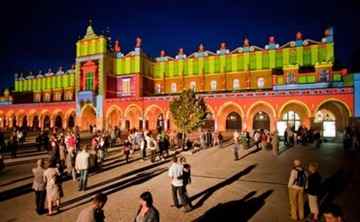Futuristic technologies in a swish new subterranean museum are bringing to life the mediaeval past of Krakow, Poland's historic and picturesque southern city that was once the seat of Polish kings.
 Four meters beneath its sprawling Old Town square, the recently opened multi-media museum covering 4,000 square meters (43,000 square feet), showcases a treasure trove of artefacts only recently discovered by archaeologists. They reveal the city's life as it once was.
Four meters beneath its sprawling Old Town square, the recently opened multi-media museum covering 4,000 square meters (43,000 square feet), showcases a treasure trove of artefacts only recently discovered by archaeologists. They reveal the city's life as it once was.
To enter, visitors must pass through a high-tech yet haunting entrance in the form of a wall of vapour that doubles as a screen reflecting scenes from hundreds of years ago.
"This museum is unique," Krakow Mayor Jacek Majchrowski says proudly. "It retraces the most ancient and little-known history of Krakow, using 21st-century technologies."
Artefacts discovered between 2005-7, offer an insight into Krakow's urban and architectural evolution even before it was formally founded in 1257.
We find parts of the city's original cobblestone lanes lined with wood, an old bridge, goldsmith and blacksmith workshops as well as the shops of wealthy merchants of the city built on trade in lead, copper and salt.
Special sound effects also immerse visitors in the world of a medieval city.
"Everything here is authentic except the skeletons lying at the bottom of the graves," discovered beneath a large part of the square, which nine centuries ago was a cemetery, says archaeologist Slawomir Dryja.
"The real skeletons -- 220 were exhumed -- were then buried in the Basilica of Notre-Dame," located nearby, he adds.
Amid the centuries' old artefacts, the flicker of touch-screen computers transport visitors back to the present, providing an impressive array of interactive multi-media and multi-lingual experiences.
On a special scale, visitors can check how much they would have weighed in units used during the Middle Ages in different parts of Europe.
Special exhibitions are devoted to children, who can discover Krakow's history and legends through games and educational activities.
A panorama of flames flicker on a giant screen depicting a fire which broke out during the Tatar invasion of 1241, destroying Krakow when it was no more than a wooden village.
The museum also traces Krakow's later history when it was part of the Hanseatic League, a powerful mediaeval alliance of cities focused on trade and commerce; and its role as the royal capital of the Kingdom of Poland which, along with the Grand Duchy of Lithuania, was a major European power between the 16th and 18th centuries.
Visitors' access to the museum is via the city's magnificent 16th-century Cloth Hall, which, as its name suggest, was home to a flourishing textile trade.
And as the focal point of the city's expansive Old Market Square, business continues there to this day.
This underground venue is the fourth museum to have opened in Krakow in recent months.
One is based in the former factory of Oskar Schindler, who saved Jews during the German occupation and inspired the Steven Spielberg film "Schindler's List"; another focuses on 19th-century art; and a third is an aviation museum.
Source: AFP [October 08, 2010]